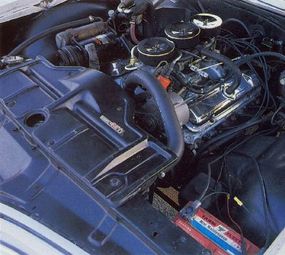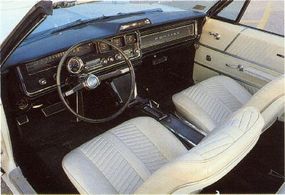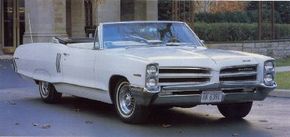Advertisement
- It was clear to most enthusiasts by 1966 that midsize models had seized the muscle car mantle. Detroit, however, was reluctant to relinquish its time-tested biggest-car/best-engine formula. Given that, it was no accident that the leader in intermediate muscle also put together the finest full-size performance machine -- the 1966 Pontiac 2+2.
- Pontiac first offered the 2+2 as a Catalina engine, suspension, and trim group in 1964. For '65, the 421-cid V-8 became a standard part of the option package, and for '66, Pontiac made the 2+2 a separate model, still based on the Catalina two-door hardtop or convertible. Flamboyantly styled and expansively proportioned, the 2+2 was unbeatable for sheer presence. It also could hold its own against a range of performance cars.
- The basic package included the heavy-duty suspension, with even stiffer springs and shocks available. Buckets and a console were added to the top-line Catalina interior, which could be optioned with a sport steering wheel and instrumentation that included a tachometer and oil-pressure gauge. Unique exterior features included "2+2" badges, twin lens taillamps, and chrome bodyside gills; Pontiac's famous eight-lug aluminum wheels were the ultimate optional touch.
- Calling into play enormous power and a decent 55/45 weight distribution, the 2+2 could be launched with little tire spin and guided through corners with alarming efficiency. And it cruised silently and rode with less harshness than muscle intermediates. The 2+2 reverted to option status for '67, then died, a proud relic of a time when big cars, Pontiacs in particular, ruled the streets.
It was clear to most enthusiasts by 1966 that midsize models had seized the muscle car mantle. Detroit, however, was reluctant to relinquish its time-tested biggest-car/best-engine formula. Given that, it was no accident that the leader in intermediate muscle also put together the finest full-size performance machine -- the 1966 Pontiac 2+2.
It was clear to most enthusiasts by 1966 that midsize models had seized the muscle car mantle. Detroit, however, was reluctant to relinquish its time-tested biggest-car/best-engine formula. Given that, it was no accident that the leader in intermediate muscle also put together the finest full-size performance machine -- the 1966 Pontiac 2+2.
Advertisement
Pontiac first offered the 2+2 as a Catalina engine, suspension, and trim group in 1964. For '65, the 421-cid V-8 became a standard part of the option package, and for '66, Pontiac made the 2+2 a separate model, still based on the Catalina two-door hardtop or convertible. Flamboyantly styled and expansively proportioned, the 2+2 was unbeatable for sheer presence. It also could hold its own against a range of performance cars.
Pontiac first offered the 2+2 as a Catalina engine, suspension, and trim group in 1964. For '65, the 421-cid V-8 became a standard part of the option package, and for '66, Pontiac made the 2+2 a separate model, still based on the Catalina two-door hardtop or convertible. Flamboyantly styled and expansively proportioned, the 2+2 was unbeatable for sheer presence. It also could hold its own against a range of performance cars.
Advertisement
The basic package included the heavy-duty suspension, with even stiffer springs and shocks available. Buckets and a console were added to the top-line Catalina interior, which could be optioned with a sport steering wheel and instrumentation that included a tachometer and oil-pressure gauge. Unique exterior features included "2+2" badges, twin lens taillamps, and chrome bodyside gills; Pontiac's famous eight-lug aluminum wheels were the ultimate optional touch.

This was the only Poncho with standard 421-cid power. The 338-bhp four-barrel was the base engine. Two tri-power 421s were optional, one with 356 bhp, the other with 376. The last was the 421 HO and included a high-output camshaft and valve train. It used a declutching fan, special exhaust manifolds, and chrome low-restriction air cleaners; rocker covers and oil-filler cap also were chrome.
Transistorized ignition was available. A three-speed stick was standard; a four-speed and automatic cost extra. The manuals had Hurst shifters. A limited-slip differential and gearing up to 4:11.1 were optional.
Advertisement

Advertisement
Calling into play enormous power and a decent 55/45 weight distribution, the 2+2 could be launched with little tire spin and guided through corners with alarming efficiency. And it cruised silently and rode with less harshness than muscle intermediates. The 2+2 reverted to option status for '67, then died, a proud relic of a time when big cars, Pontiacs in particular, ruled the streets.
Calling into play enormous power and a decent 55/45 weight distribution, the 2+2 could be launched with little tire spin and guided through corners with alarming efficiency. And it cruised silently and rode with less harshness than muscle intermediates. The 2+2 reverted to option status for '67, then died, a proud relic of a time when big cars, Pontiacs in particular, ruled the streets.
Return to Classic Muscle Cars Library.
Advertisement
- Pontiac ignited the classic muscle car era with a stroke of marketing genius. See profiles, photos, and specifications of Pontiac muscle cars.
- Muscle cars came in many shapes and sizes. Here are features on more than 100 muscle cars, including photos and specifications for each model.
- Muscle cars created their own culture. To learn about it, read How Muscle Cars Work.
These muscle car profiles include photos and specifications for each model:
- Cougar pulled out of Mustang's shadow with the striped and spoilered 1969 Mercury Cougar Eliminator.
- Beep, beep! Make way for one of the baddest muscle cars of all time, the 1970 Plymouth Road Runner Hemi.
- The 1970 Pontiac Firebird Trans Am combined sports-car handling and muscle car power.
- An all-aluminum, race-proven V-8 defined the rare and wicked 1969 Chevrolet Camaro ZL1.
For related car information, go to these articles:
- The engine is what gives a muscle car its flamboyant personality. To learn everything you need to know about car engines, see How Car Engines Work.
- Muscle cars wouldn't have much muscle without horsepower -- but what exactly is horsepower? How Horsepower Works answers that question.
- NASCAR race cars embody the muscle car philosophy of power. Read How NASCAR Race Cars Work to find out what makes these charged-up racers go.
- Are you thinking of buying a 2007 muscle car, or any other car? See Consumer Guide Automotive's New-Car Reviews, Prices, and Information.
Advertisement
